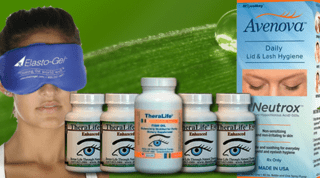Who gets ocular rosacea?
For many people afflicted with the skin condition known as rosacea, there may be a new challenge on the horizon. A similar condition called ocular rosacea can lead to redness, itching, and burning of the eyes. This condition affects about 60% of people with skin rosacea, but can strike others as well. Scientists do not know the exact cause of this painful irritation, but can help those who experience it.
As a poorly-understood inflammatory condition, ocular rosacea affects men and women equally. It is most common in people who also experience the redness and flushing of skin rosacea, but is also relatively common in those who blush easily. People aged 30 to 50 years are the primary group who have to deal with this uncomfortable condition.
How TheraLife Can Help
TheraLife developed proprietary formulas to control inflammation, revive and restore your own tear production intra-cellularly. From inside out. No more drops.
To learn more
Order Now
Ocular Rosacea Recovery – a Personal Story
Severe Chronic Dry Eyes- ocular rosacea
I have had chronic severe dry eyes for many years I am writing to let you know how thankful I am for your product- TheraLife Eye. It has virtually changed my life. Instead of ALWAYS thinking about my sore, red, dry eyes, I NEVER think about them anymore.
And every time I look in the mirror and see my bright, wide, youthful looking eyes I make a little wish that your company is thriving and I will never again have to be without TheraLife Eye capsules. You know, when your eyes are red and you squint in discomfort, you really do look older.
I’ll be traveling to Las Vegas soon and am anxious to see how I do in the desert air. Wish me luck! A bottle of TheraLife Eye will be in my purse for sure.
Thank you, thank you, thank you.
C.L. Ohio, United States
Ocular Rosacea: Signs and Symptoms
There are several common signs and symptoms of ocular rosacea, including:
- Itching of the eyes and eyelids
- Redness of the eyes
- Irritation and swelling of the eyelids
- Dry, gritty-feeling eyes
- Blurred vision
- Burning sensations in and around the eyes
Ocular rosacea may be triggered by environmental factors as well as such aspects as spicy or hot foods and beverages, strenuous exercise, and emotional triggers like embarrassment, excitement, and anger. Flare-ups may be mild, resolving quickly, or they may persist for days. Left untreated, the condition can worsen and potentially lead to lost vision.
Is There a Cure for Ocular Rosacea?
Unfortunately, there is no cure for the inflammatory condition medical professionals call ocular rosacea. However, the condition can be controlled by medication, particularly anti-inflammatory medicines, steroid-containing creams, and oral antibiotics in certain circumstances.
Over-the-counter preparations that help the eye produce tears, such as the TheraLife line of products, may also provide substantial relief during flare-ups.
Diagnosis of Ocular Rosacea
There is no test or diagnostic standard for ocular rosacea; the caregiver will evaluate the signs and symptoms the patient experiences, then rule out other causes. Diagnosis also includes reviews of the patient’s lifestyle and medical histories.
If a patient is determined to suffer from ocular rosacea, medications can be prescribed. Physicians can also provide at-home remedies to help reduce painful redness and itching. Tips to manage the condition include:
- Avoiding triggers that can cause flare-ups, such as spicy foods, hot foods and beverages, and sun/wind exposure.
- Avoiding eye makeup, particularly when flare-ups occur. If makeup is used, it should be non-comedogenic and free of fragrances.
- Avoiding the use of contact lenses to correct vision.
- Keeping eyelid and eye areas clean by cleansing with a gentle solution and warm (not hot) water.
Protecting the eyes when outdoors is beneficial, particularly when it is windy and sunny. Protective sunglasses should be worn to minimize irritation. Continue reading more tips to managing the condition.
Conclusion
There is no medical cure for ocular rosacea symptoms, and medical professionals still do not know the exact cause of the condition. By adhering to eye-area cleanliness and by avoiding common triggers, people with the condition can minimize or even eliminate most flare-ups. Those people with chronic itchy, watery, and burning eyes should seek medical attention as soon as possible. Medications may help alleviate the unpleasant symptoms of this inflammatory eye response.
Learn more: Why Are My Eyes Dry at Night? 16 Symptoms of Dry Eye Treatment Options






Do you really think you know what you are talking about. You only speak about a tiny part of the picture. Get informed watch this:
Watch “Dry Eyes and Tear Dysfunction Syndrome: Causes, Symptoms, and Treatments” on YouTube
https://youtu.be/SH7ELystIb0
Dr. Mina Massaro-Giordano, MD Co-Director Univ. Penn. Dry Eye Center. Shere Eye Institute
Tear dysfunction system
Thank you for sharing